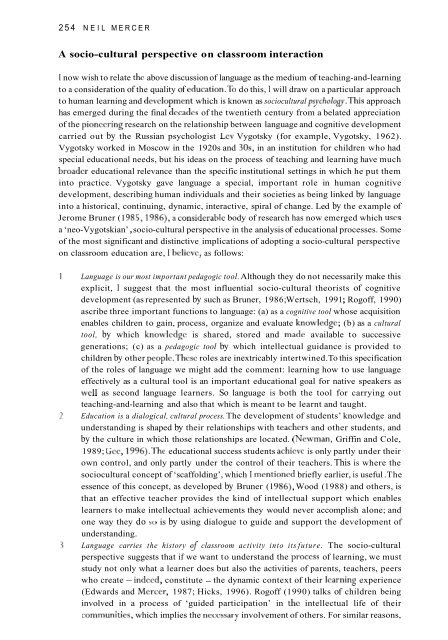English Language Teaching in its Social Context
English Language Teaching in its Social Context
English Language Teaching in its Social Context
You also want an ePaper? Increase the reach of your titles
YUMPU automatically turns print PDFs into web optimized ePapers that Google loves.
254 NEIL MERCERA socio-cultural perspective on classroom <strong>in</strong>teractionI now wish to relate the above discussion of language as the medium of teach<strong>in</strong>g-and-learn<strong>in</strong>gto a consideration of the quality of education.To do this, I will draw on a particular approachto human learn<strong>in</strong>g and devclopment which is known as sociocultural psycholou.This approachhas emerged dur<strong>in</strong>g the f<strong>in</strong>al dccadcs of the twentieth century from a belated appreciationof the pioneer<strong>in</strong>g research on the relationship between language and cognitive developmentcarried out by the Russian psychologist Lcv Vygotsky (for example, Vygotsky, 1962).Vygotsky worked <strong>in</strong> Moscow <strong>in</strong> the 1920s and 30s, <strong>in</strong> an <strong>in</strong>stitution for children who hadspecial educational needs, but his ideas on the process of teach<strong>in</strong>g and learn<strong>in</strong>g have muchbroader educational relevance than the specific <strong>in</strong>stitutional sett<strong>in</strong>gs <strong>in</strong> which he put them<strong>in</strong>to practice. Vygotsky gave language a special, important role <strong>in</strong> human cognitivedevelopment, describ<strong>in</strong>g human <strong>in</strong>dividuals and their societies as be<strong>in</strong>g l<strong>in</strong>ked by language<strong>in</strong>to a historical, cont<strong>in</strong>u<strong>in</strong>g, dynamic, <strong>in</strong>teractive, spiral of change. Led by the example ofJerome Bruner (1 985,1986), a considerablc body of research has now emerged which USCSa ‘neo-Vygotskian’ , socio-cultural perspective <strong>in</strong> the analysis of educational processes. Someof the most significant and dist<strong>in</strong>ctive implications of adopt<strong>in</strong>g a socio-cultural perspectiveon classroom education are, I belicvc, as follows:<strong>Language</strong> is our most important pedagogic tool. Although they do not necessarily make thisexplicit, I suggest that the most <strong>in</strong>fluential socio-cultural theorists of cognitivedevelopment (as represented by such as Bruner, 1986; Wertsch, 1991 ; Rogoff, 1990)ascribe three important functions to language: (a) as a cognitive tool whose acquisitionenables children to ga<strong>in</strong>, process, organize and evaluate knowledge; (b) as a culturaltool, by which knowlcdge is shared, stored and made available to successivegenerations; (c) as a pedagogic tool by which <strong>in</strong>tellectual guidance is provided tochildren by other peoplc.Thcsc roles are <strong>in</strong>extricably <strong>in</strong>tertw<strong>in</strong>ed. To this specificationof the roles of language we might add the comment: learn<strong>in</strong>g how to use languageeffectively as a cultural tool is an important educational goal for native speakers aswell as second language learners. So language is both the tool for carry<strong>in</strong>g outteach<strong>in</strong>g-and-learn<strong>in</strong>g and also that which is meant to be learnt and taught.Education is a dialogical, cultural process. The development of students’ knowledge andunderstand<strong>in</strong>g is shaped by their relationships with teachers and other students, andby the culture <strong>in</strong> which those relationships are located. (Newman, Griff<strong>in</strong> and Cole,1989; Gee, 1996).The educational success students achieve is only partly under theirown control, and only partly under the control of their teachers. This is where thesociocultural concept of ‘scaffold<strong>in</strong>g’, which I mentioned briefly earlier, is useful .Theessence of this concept, as developed by Bruner (1986), Wood (1988) and others, isthat an effective teacher provides the k<strong>in</strong>d of <strong>in</strong>tellectual support which enableslearners to make <strong>in</strong>tellectual achievements they would never accomplish alone; andone way they do $0 is by us<strong>in</strong>g dialogue to guide and support the development ofunderstand<strong>in</strong>g.<strong>Language</strong> carries the history .f classroom activity <strong>in</strong>to <strong>its</strong> future. The socio-culturalperspective suggests that if we want to understand the proccss of learn<strong>in</strong>g, we muststudy not only what a learner does but also the activities of parents, teachers, peerswho create ~ <strong>in</strong>deed, constitute - the dynamic context of their learn<strong>in</strong>g experience(Edwards and Mercer, 1987; Hicks, 1996). Rogoff (1990) talks of children be<strong>in</strong>g<strong>in</strong>volved <strong>in</strong> a process of ‘guided participation’ <strong>in</strong> thc <strong>in</strong>tellectual life of theircommunitieq, which implies the neccssary <strong>in</strong>volvement of others. For similar reasons,












